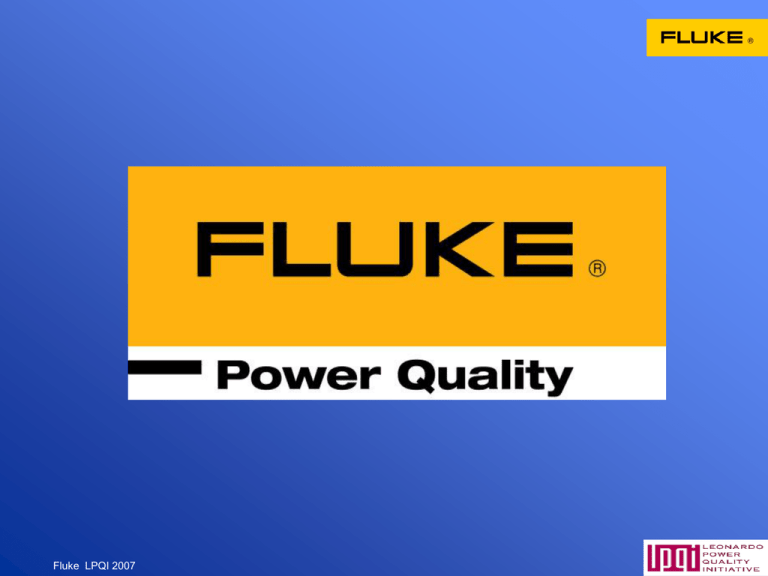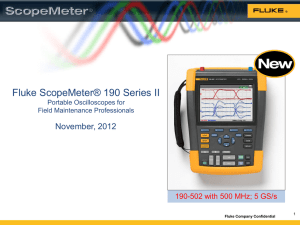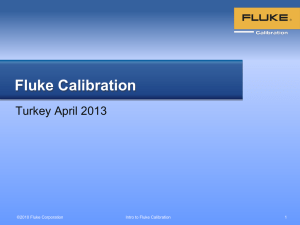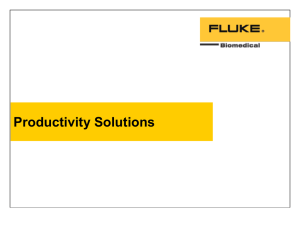Power Measurement
advertisement

Fluke LPQI 2007 1 Fluke Corporation European Headquarters Eindhoven, the Netherlands Corporate Headquarters near Seattle, WA, USA Fluke LPQI 2007 2 Fluke Corporation • Founded in basement of John Fluke’s home in Springdale, Connecticut, USA in 1948 • 2,400 employees worldwide • Offices in 21 countries around the world • Distributed in more than 100 countries • Manufacturing facilities in Everett (USA), the Netherlands, the U.K. and China Fluke LPQI 2007 3 Measurements for Power Quality maintenance Fluke PDM seminar Module 1 4 Industry trends 1) Growing concern for personal safety - complexity of today’s systems, bring over voltage risks international & national regulations (& guidance) 2) Increased attention on power related issues - deregulation of power distribution Increasing loads on power systems 3) Shift from reactive maintenance to preventive maintenance – More work by fewer people – Decreasing maintenance budget – More complex equipment Fluke LPQI 2007 5 History of Maintenance Practices • 20 years ago… Tool use by application* TREND Scheduled Predictive •Thermal Imaging •Ultrasonic testing •Vibration Analyzers •Recorders/Loggers •Motor/Circuit Test •Oil Testers Preventive •PQ Analyzers •IR Temperature •Insulation testers Reactive Fluke LPQI 2007 •Network Test •Scope Meters •Loop Cal. •Clamp Meter •DMM •Simple Testers – The primary goal of maintenance was loss prevention and the fundamental requirement was to provide the basic need at minimum cost. • Today… – Companies are researching all possible means to extend the productive life 6 Types of Maintenance Break-down Reactive Maintenance Cost Repair it when it fails Preventive Maintenance Cost Time Maintenance at regular intervals Predictive Maintenance Cost Time Problem detected before predicted failure. Maintenance planned ahead Time Fluke LPQI 2007 7 Power Quality • Effects of bad power quality are not immediately obvious • Bad power quality can come from anywhere • Consequences could be severe (production loss) • Power quality problems are a root cause: – – – – Malfunction Shutdown Excessive energy cost Decreased lifetime of equipment Fluke LPQI 2007 8 Example Fluke PDM seminar Module 1 9 Example • This manufacturer is the third biggest power consumer of the local energy supplier. They produce fiber materials for sports equipment. • A new heating system was installed on a key process • During a routine check with a thermographic camera it was discovered there had been an increase in temperature of the neutral conductor. • Check with a current clamp revealed 20A Phase currents & 40A Neutral current Fluke LPQI 2007 10 Example • A power quality logger was used to gather the needed data. • Connection was only possible on the distribution board connection, fused with 250A, not at the heater due to safety reasons. • This makes analysis a bit more complex since the heater represents a small part of the total load Fluke LPQI 2007 11 Results Current trend Neutral current Question: Why does the neutral carry 60A and not only 6A which would be the difference between currents in L1, L2 and L3? Fluke LPQI 2007 12 Results 2 • Conclusion; there is a third harmonic present in the neutral Fluke LPQI 2007 13 Conclusion Further analysis showed that: 10A fund 35A 3rd • The reason for the neutral conductor overload clearly is the heating installation, which generates high triplen harmonics • More unbalances present so further more measurements would be very helpful. What was the cause? • Regulators built into the heating system require harmonic filters which were not installed Fluke LPQI 2007 14 Conclusion • Thermal survey gives early warning of a problem • Addition of new equipment can introduce problems which are not obvious or visible • Performing system check “before” and “after” can prevent future failures • “Balanced” loads still can have harmonic content running in the neutral Fluke LPQI 2007 15 Measurement of Electrical Systems Fluke PDM seminar Module 1 16 Measurement 1. Safety 2. Power Quality Measurement The effect of distortion on simple test tools Measurement of Harmonics Measurement Specifications Typical measurements 3. Power Quality Measurement Equipment Basic Measurements Test equipment types Fluke LPQI 2007 17 Measurement 1. Safety 2. Power Quality Measurement The effect of distortion on simple test tools Measurement of Harmonics Measurement Specifications Typical measurements 3. Power Quality Measurement Equipment Basic Measurements Test equipment types Fluke LPQI 2007 18 Safety of Measurement • Example – DMM fitted with low energy fuse used incorrectly on a high energy circuit Fluke LPQI 2007 19 EN61010 LV Directive Implemented in 1998 All instruments have to be tested by an independent test house (2004) Each instrument must be marked with an Overvoltage Category ( CAT I, II, III, IV ) As well as a voltage level (300, 600, 1000 Volts) Fluke LPQI 2007 20 Category Rating • CAT IV - Electricity meters and primary connection • CAT III - Permanent connection to the fixed installation. • CAT II - Appliances, portable tools etc. • CAT I - Protected electronic circuits. Fluke LPQI 2007 21 Voltage Rating per Category Test Impulse Rating Voltage Phase-Zero CAT I CAT II CAT III 300 1500 2500 4000 600 2500 4000 6000 1000 4000 6000 8000 Source Impedance 30 Ω 12 Ω 2Ω Fluke LPQI 2007 CAT IV 8000 2Ω 22 IEC 1010 / EN61010 • Regulations are not an option • Second edition EN61010 ( 2004 ) requires independent testing • Remember Test leads are CAT rated ... Fluke LPQI 2007 23 Available from Fluke • • • • Free Safety DVD Not sales focused Information on EN61010 Interview with an arc blast survivor Fluke LPQI 2007 24 Measurement Seminar 1. Safety 2. Power Quality Measurement The effect of distortion on simple test tools Measurement of Harmonics Measurement Specifications Typical measurements 3. Power Quality Measurement Equipment Basic Measurements Test equipment types Fluke LPQI 2007 25 Harmonics Distorted waveforms Harmonic frequencies combine with the fundamental sine wave to form non-sinusoidal (distorted) waveforms. 1 3 sin(x) 0.8*sin(3*x+3.6) 0.5*sin(5*x+0.6) 0.22*sin(7*x+3.8) 0.8 0.6 sin(x)+0.8*sin(3*x+3.6)+0.5*sin( 5*x+0.6) +0.22*s in(7*x+3.8) 2 0.4 1 0.2 = 0 -0.2 -0.4 -0.6 0 -1 -2 -0.8 -1 -3 0 1 Fluke LPQI 2007 2 3 t [msec] 4 5 6 0 1 2 3 t [msec] 4 5 26 6 Effect of distortion on test tools Fluke PDM seminar Module 1 27 Measurement Methods • Both Clamp Meter’s are calibrated and functioning correctly 59.2 A AC Fluke LPQI 2007 40.5 A AC 28 Measurement Sinewave • How does a measurement device measure the effective value of a waveform ? • Two Methods - Averaging & True RMS Fluke LPQI 2007 29 Averaging Measurement • Effective (RMS) value = 1.11 X Average value. Fluke LPQI 2007 30 Non-linear Loads Switching Power Supply Volts Amps • What happens to the measurement device if the waveform is distorted by non-linear loads ? Fluke LPQI 2007 31 Measurement Distorted Waveform • Effective (RMS) value = 1.85 x Average value. • An averaging measurement device (1.11 x) would read up to 40 % too low. RMS AVG Fluke LPQI 2007 32 Nuisance tripping at 60A ? True RMS Measurement Averaging Measurement 59.2 A AC 40.5 A AC Fluke LPQI 2007 33 True RMS Measurement True RMS / Harmonics • A True RMS meter calculates the effective heating value of the distorted waveform • This will include all harmonics Fluke LPQI 2007 34 Crest Factor • Peak value = 1.414 X RMS value. • 1.414 = Crest Factor. Fluke LPQI 2007 35 Crest Factor Distorted Waveform • Peak value = 2.9 X RMS Value. • 2.9 = Crest Factor. Pea k RMS Fluke LPQI 2007 36 Crest Factor Distorted Waveforms C.F. = 1.43 C.F. = 2.39 C.F. = 4.68 • Professional Multimeters usually rated at CF <3 • High Quality units rated at CF of 6 • Power Quality Analyzer CF >11 Fluke LPQI 2007 37 Power Measurement Two Power Factors Screen Shots from a Fluke 43 Single Phase and a Fluke 434 Three Phase analyser Fluke LPQI 2007 38 Power Measurement • System with no Harmonic content Reactive power (kVAr) Apparent power (kVA) True Power (W) Cos φ (dpf) = true power (fundamental) Fluke LPQI 2007 39 Power Measurement • System with Harmonic content Reactive power (kVAr) Apparent power including harmonics (kVA) True Power (W) Reactive power (Harmonic component) Cos φ (dpf) : true power/Reactive power (fundamental) PF: true power/reactive power (incl harmonics) Fluke LPQI 2007 40 Power Measurement Two Power Factors ! Screen Shots from a Fluke 43 Single Phase and a Fluke 434 Three Phase analyser Fluke LPQI 2007 41 Measurement where Harmonics are present 1. Always use True RMS 2. Check the crest factor rating 3. When measuring power be aware of PF vs Cos φ/(DPF) C.F. = 1.43 Fluke LPQI 2007 C.F. = 2.39 C.F. = 4.68 42 2) Measurement of Harmonics Fluke PDM seminar Module 1 43 EN50160 Harmonics Upper limits for individual harmonic voltages at the supply terminals in % of nominal voltage. 95% of 10-minute average Vrms over 1 week must be below limits Odd harmonics Even Harmonics Not multiples of 3 Multiples of 3 Order h Relative voltage Order h Relative voltage Order h Relative voltage 5 6% 3 5% 2 2% 7 5% 9 1.5 % 4 1% 11 3.5 % 15 0.5 % 6…24 0.5 % 13 3% 21 0.5 % 17 2% 19 1.5 % 23 1.5 % 25 1.5 % VIRTUALLY ALL HARMONIC PROBLEMS ARE GENERATED “IN HOUSE” Fluke LPQI 2007 44 IEC 61000-4-30 specification Test Equipment Class B Class A Measurement Interval Accuracy Hz 10 sec ± 10mHz Manufacturer to indicate Magnitude supply voltage Vrms 10 cycles ± 0.1% Manufacturer to indicate Flicker (IEC 61000-4-15) Plt 2 hr ± 5% Manufacturer to indicate Voltage dips, swells and interruptions, rapid voltage changes ½ cycle Vrms 10 ms ± 0.2% ½ cycle Vrms Unbalance (method of symmetrical components) Vrms fundamental 10 cycles ± 0.15% (uncert.) Manufacturer to indicate THD, Harm V, A, Inter harmonics 10 cycles ± 1-5% Manufacturer to indicate V peak 50 μ sec (200KS/s) Inter harmonic 10 cycles ± 1-5% Manufacturer to indicate Power frequency Harmonics (IEC 61000-4-7) Transients (not specified) Mains signaling Flagging Dip, swells, interruptions might create unreliable readings of Hz, Vrms, Unbalance and Harm. Therefore Must be re flagged (dirty) to avoid miss interpretation Not specified Time synchronization External clock; GPS Manufacturer to indicate Fluke LPQI 2007 1 period 45 Harmonic Measurement • For troubleshooting – Check the harmonics present – Check for the levels of the harmonics – Look for recognizable patterns 50 Hz Fluke LPQI 2007 100 Hz 150 Hz 200 Hz 46 Harmonic Measurement – PC Load V, A, Hz Measurement Fluke LPQI 2007 Harmonic Measurement 3rd Harmonic Content 47 Harmonic Measurement Desktop System Compact Fluorescent Lamp with HF Ballast 0.6000 0.0600 0.5000 0.0500 0.4000 Current (A) Current (A) 0.0400 0.3000 0.2000 0.0300 0.0200 0.1000 0.0100 0.0000 0.0000 1 2 3 4 5 6 7 8 9 10 11 12 13 14 15 16 17 1 2 3 4 5 6 Harmonic 7 8 9 10 11 12 13 14 15 16 17 Harmonic PC / IT Load Elec. Fluorescent Lighting Ballast Twelve pulse bridge - harmonic current Six pulse bridge - harmonic current 25 25 20 20 15 15 % % 10 10 5 5 0 1 2 3 4 5 6 7 8 9 10 11 12 13 14 15 16 17 18 19 20 21 22 23 24 25 Harmonic number 0 1 2 3 4 5 6 7 8 9 10 11 12 13 14 15 16 17 18 19 20 21 22 23 24 25 Harmonic number 6 Pulse Bridge Fluke LPQI 2007 12 Pulse Bridge 48 Measurement Seminar 1. Safety 2. Power Quality Measurement The effect of distortion on simple test tools Measurement of Harmonics Measurement Specifications Typical measurements 3. Power Quality Measurement Equipment Basic Measurements Test equipment types Fluke LPQI 2007 49 Types of Measurement Tools 1. Power Quality Troubleshooting / Survey tools – Devices designed as a measurement tool – Simple to use / Immediate measurements – Troubleshooting / Survey tool / some logging 2. Power Quality “Logging” – Devices designed for long term monitoring – Record every parameter for detailed analysis – Predictive Maintenance Fluke LPQI 2007 50 Power Quality Troubleshooting & Surveys • Measurements 1. 2. 3. 4. 5. 6. 7. 8. 9. Volts Amps & Frequency Power Harmonics Dips & Swells Transients Unbalance Flicker Inrush Temperature Fluke LPQI 2007 51 1) Volts, Amps & Frequency • Using a Power Quality Analyser • View all of the main parameters at point of connection • Graphical as well as numeric display can help highlight potential problems Scope Vector Trend Fluke LPQI 2007 52 2) Power Measurement • Typical power measurement information • Shows the sides of the triangle Fluke LPQI 2007 53 3) Three Phase Harmonic Measurement Fluke LPQI 2007 54 4) Transient Measurement • Cause….. interference • Difficult to capture – Triggering of ‘scopes difficult…width, timing, peak value ? • Modern power quality analyzers purpose built for the job • Envelope trigger • Accurate real time stamping is essential +X% 240V - X% Fluke LPQI 2007 55 5) Dips and Swells • Recording of upstream and downstream sags can indicate loads causing problems Upstream Sag Fluke LPQI 2007 Downstream Sag 56 6) Unbalance • The phase diagram gives a quick indication of phase relationships and balance • In this example voltage unbalance is very small, but current unbalance is nearly 19%. Fluke LPQI 2007 57 7) Flicker Measurements • A reading greater than 1 means that most people will perceive flicker in an incandescent bulb • Measurement – Pst (1 min): Short-term flicker over 1 minute – Pst: Short-term flicker over 10 minutes – Plt: Long-term flicker over 2 hours Fluke LPQI 2007 58 8) Inrush • Inrush Current Measurement – Momentary peak of current during switch on. – Current clamps can capture peak reading – Analyzers can give time measurement Screen Shot of a PQA showing start-up current generated by a cooling system Three Phase Inrush Measurement Fluke LPQI 2007 59 9) Temperature • Many power quality problems initially result in an increase in temperature of components, connectors, cables and machinery • Infra red non contact measurement is the ideal way to locate this type of problem Fluke LPQI 2007 60 Why infrared non-contact measurement? 1) Measurement from distance • Dangerous to contact (Electrical) • Difficult to reach • Moving objects 2) Measurement without contact • Very hot objects • Where contact would damage, contaminate or change temperature (Food & Chemical) Fluke LPQI 2007 61 Example Substations Fluke LPQI 2007 62 Substations Both qualitative and quantitative inspections are Required to determine a fault Fluke LPQI 2007 63 Electrical connections The connections on this evaporator pump read over 50 degrees hotter on phase 3 Fluke LPQI 2007 64 Electrical connections • The temperature readouts show that connection on the centre phase of this main lighting disconnect are hot, suggesting an unbalanced load Fluke LPQI 2007 65 Electrical connections Fluke LPQI 2007 66 Electrical unbalance or overload? Fluke LPQI 2007 67 Electrical unbalance or overload? • Where is the increased resistance? On the left or on the right contact? • A hot spot is not necessarily a faulty connection! Fluke LPQI 2007 68 Fluke Power Quality Fluke PDM seminar Module 1 69 Single Phase Troubleshooting Fluke 345 Power Clamp Fluke LPQI 2007 Fluke 43B Analyzer 70 Three Phase Troubleshooting Fluke 435 Power Quality Troubleshooter Fluke LPQI 2007 Fluke 1735 Power Logger 71 Power Quality Logging Fluke 1740 Series Power Quality Logger Fluke LPQI 2007 Fluke 1760 Power Quality Logger 72 Thermal Imaging FlukeTi20 Thermal Imaging Camera Fluke LPQI 2007 FlukeTi40 & Ti50 Advanced Camera’s 73 More information • Fluke Power Quality Data available in the exhibition area • DVD’s – Thermal Imaging Application DVD – Safety DVD – EN61010 – Power Quality Measurement DVD • Fluke Website – www.fluke.co.uk • Short term requirement ? Fluke LPQI 2007 74 Fluke PDM seminar Module 1 75








